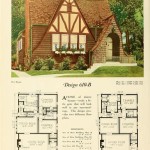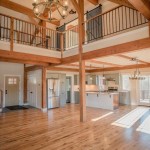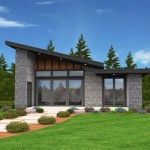Small home house plans are blueprints or designs that provide the framework for constructing compact, yet functional and comfortable residential structures. These plans are carefully crafted to optimize space utilization, making them suitable for individuals or families who desire a cozy and efficient living environment. One example of a small home house plan is a charming 700-square-foot cottage featuring a single bedroom, one bathroom, a modern kitchen, and an open-plan living and dining area.
The growing popularity of small home house plans can be attributed to numerous advantages they offer. Their affordability compared to larger homes makes them an attractive option for first-time homebuyers, retirees, or those seeking a more budget-friendly lifestyle. Additionally, with a smaller living space to maintain, these homes require less time and effort to clean and upkeep. Their reduced energy consumption further contributes to cost savings, making them an environmentally conscious choice as well.
Further exploration into the various aspects of small home house plans, including their design principles, sustainable features, and innovative storage solutions, will provide a comprehensive understanding of their benefits and versatility. By delving into these details, we can appreciate the unique advantages that small home house plans offer in addressing the evolving needs of modern living.
When considering small home house plans, there are several key points to bear in mind:
- Maximize space utilization
- Prioritize natural light
- Incorporate clever storage
- Choose energy-efficient materials
- Consider sustainable features
- Plan for outdoor living
- Allow for future expansion
- Adhere to local building codes
- Hire a qualified architect or designer
- Set a realistic budget
By carefully considering these factors, you can create a small home that is both comfortable and functional.
Maximize space utilization
In small home house plans, maximizing space utilization is of utmost importance. Every square foot should be carefully considered to ensure that the space is used efficiently and effectively. There are several key strategies that can be employed to achieve this goal:
- Open floor plans: By eliminating unnecessary walls and partitions, open floor plans create a more spacious and airy feel. This approach allows for a seamless flow of movement between different areas of the home, making it feel larger than it actually is.
- Multi-purpose spaces: Designing rooms that can serve multiple functions is a clever way to maximize space utilization. For example, a guest room can also be used as a home office, or a living room can double as a dining area. By incorporating convertible furniture, such as sofa beds or nesting tables, you can further enhance the versatility of your space.
- Vertical storage: Making use of vertical space is essential in small homes. Install floating shelves, stackable bins, and overhead cabinets to store items off the floor. Utilize the height of your walls by adding floor-to-ceiling bookshelves or built-in storage units.
- Declutter and organize: Regularly decluttering and organizing your belongings can significantly improve the perceived spaciousness of your home. Donate or discard items you no longer need, and find efficient storage solutions for the rest. A tidy and organized home feels more inviting and comfortable.
By implementing these space-maximizing strategies, you can create a small home that feels both cozy and comfortable, without sacrificing functionality or style.
Prioritize natural light
Incorporating ample natural light into your small home house plan is essential for creating a bright, airy, and welcoming living space. Natural light not only reduces the need for artificial lighting, but it also has numerous health and well-being benefits, such as improved mood, increased productivity, and better sleep quality.
- Windows and skylights: Strategically placed windows and skylights can flood your home with natural light. Consider installing large windows in south-facing rooms, as they receive the most sunlight throughout the day. Skylights are another excellent way to bring light into darker areas of your home, such as hallways or bathrooms.
- Light-colored walls and furnishings: Light-colored walls and furnishings reflect light, making your home feel more spacious and brighter. Choose light shades of paint, wallpaper, and furniture to maximize the impact of natural light.
- Mirrors: Mirrors can reflect and distribute natural light throughout your home. Place mirrors opposite windows or in areas with limited natural light to create the illusion of a larger and brighter space.
- Courtyards and patios: If your home has a courtyard or patio, design it to seamlessly connect with your indoor living spaces. This will allow natural light to penetrate deeper into your home and create a more cohesive indoor-outdoor flow.
By prioritizing natural light in your small home house plan, you can create a more inviting, healthier, and more energy-efficient living environment.
Incorporate clever storage
Incorporating clever storage solutions is essential for maximizing space utilization and maintaining a tidy and organized home. Here are some innovative storage ideas to consider for your small home house plan:
- Built-in storage: Built-in storage units, such as bookshelves, cabinets, and drawers, can be seamlessly integrated into the walls and other structural elements of your home. This type of storage is not only space-efficient but also aesthetically pleasing, as it creates a cohesive and polished look.
- Multi-purpose furniture: Choose furniture that serves multiple functions, such as ottomans with built-in storage or coffee tables with hidden drawers. This allows you to store items discreetly without sacrificing style or comfort.
- Vertical storage: Make use of vertical space by installing floating shelves, stackable bins, and overhead cabinets. Vertical storage is particularly useful in small spaces, as it allows you to store items off the floor and maximize the use of wall space.
- Hidden storage: Utilize hidden storage compartments, such as under-bed drawers, behind-mirror cabinets, and pull-out shelves, to store items that are not frequently used. Hidden storage helps to keep your home clutter-free and organized.
By incorporating clever storage solutions into your small home house plan, you can create a space that is both functional and aesthetically pleasing, without feeling cramped or cluttered.
Choose energy-efficient materials
Selecting energy-efficient materials for your small home house plan is crucial for reducing your energy consumption and lowering your utility bills. Here are some key materials to consider:
- Insulation: Proper insulation is essential for maintaining a comfortable indoor temperature and reducing heat loss. Choose high-quality insulation materials, such as cellulose, fiberglass, or spray foam, to minimize heat transfer through walls, ceilings, and floors.
- Windows and doors: Energy-efficient windows and doors are designed to reduce heat transfer and air leakage. Look for windows with double or triple glazing, low-emissivity coatings, and ENERGY STAR certification. Similarly, choose doors with weatherstripping and insulation to minimize drafts.
- Appliances: Energy-efficient appliances consume less energy to operate, reducing your electricity usage. When purchasing appliances, look for the ENERGY STAR label, which indicates that the appliance meets strict energy efficiency standards.
- Lighting: LED and CFL bulbs are far more energy-efficient than traditional incandescent bulbs. By switching to energy-efficient lighting, you can significantly reduce your electricity consumption.
By choosing energy-efficient materials for your small home house plan, you can create a more sustainable and cost-effective living space.
Consider sustainable features
Incorporating sustainable features into your small home house plan is a responsible and forward-thinking decision. Sustainable features can reduce your environmental impact, improve your indoor air quality, and potentially increase the value of your home.
- Energy efficiency: As mentioned earlier, choosing energy-efficient materials and appliances can significantly reduce your energy consumption and utility bills. Additionally, consider incorporating passive solar design principles to maximize natural heating and cooling, and installing a renewable energy system, such as solar panels or a geothermal heat pump.
- Water conservation: Installing low-flow fixtures and appliances can reduce your water consumption. Consider collecting rainwater for irrigation or other non-potable uses, and implement landscaping techniques that minimize water usage.
- Sustainable materials: Choose building materials that are sustainably sourced and produced. Look for materials with low embodied energy, such as recycled or reclaimed materials, and opt for finishes with low VOC (volatile organic compound) emissions to improve indoor air quality.
- Indoor air quality: In addition to choosing low-VOC finishes, consider installing a mechanical ventilation system to improve air circulation and remove pollutants. Incorporate natural elements, such as plants and natural light, to create a healthier and more inviting living environment.
By considering sustainable features in your small home house plan, you can create a more eco-friendly, comfortable, and healthy living space.
Plan for outdoor living
Extending your living space outdoors is a wonderful way to enjoy the fresh air and expand your entertaining options. When planning for outdoor living in a small home, it’s important to make the most of the available space and create a cohesive flow between the indoor and outdoor areas.
- Create a seamless transition: Design your outdoor living space as an extension of your indoor living area. Use similar materials, colors, and textures to create a cohesive look and feel. Large sliding doors or bi-fold windows can seamlessly connect the two spaces, allowing for easy flow of traffic and natural light.
- Maximize vertical space: In small outdoor areas, vertical space is your friend. Install trellises or pergolas to support climbing plants, creating privacy screens and adding a touch of greenery. Wall-mounted planters and hanging baskets are other great ways to add plants and flowers without taking up valuable floor space.
- Choose multi-purpose furniture: Opt for outdoor furniture that serves multiple functions. Benches with built-in storage can double as seating and storage for cushions or gardening tools. Tables with extendable leaves can accommodate larger groups for dining or entertaining.
- Incorporate lighting: Proper lighting is essential for creating a welcoming and functional outdoor living space. Install a combination of ambient, task, and accent lighting to create different moods and highlight specific areas. Consider using solar-powered lights to save energy and reduce maintenance.
By carefully planning for outdoor living in your small home, you can create a comfortable and inviting space that seamlessly extends your living area and enhances your enjoyment of the outdoors.
Allow for future expansion
When creating a small home house plan, it’s wise to consider the possibility of future expansion. Life circumstances can change, and your small home may eventually need to accommodate a growing family, additional living space, or evolving needs. By planning for future expansion from the outset, you can ensure that your home can adapt and grow alongside your family and lifestyle.
One way to allow for future expansion is to design your home with a flexible layout. Avoid creating fixed walls or partitions that would limit future modifications. Instead, opt for open floor plans and modular designs that can be easily reconfigured as your needs change. For example, a large open-plan living area could be subdivided into separate rooms in the future, or a loft space could be converted into an additional bedroom.
Another important consideration is to provide adequate space for potential additions. When selecting a lot for your small home, choose one that is large enough to accommodate future expansion. Consider the orientation of your home and the surrounding area to determine the best location for any future additions. Additionally, ensure that your foundation and structural system are designed to support the weight of potential additions.
Finally, consider incorporating design elements that can facilitate future expansion. For example, installing headers above windows and doors can provide the necessary support for adding a second story in the future. Additionally, leaving extra space in your electrical and plumbing systems can make it easier to add on to your home later on.
By allowing for future expansion in your small home house plan, you can create a flexible and adaptable living space that can meet your changing needs over time.
Adhere to local building codes
Adhering to local building codes is of paramount importance when designing and constructing small home house plans. Building codes are regulations established by local authorities to ensure the safety, structural integrity, and habitability of buildings. Ignoring or violating building codes can lead to significant problems, including fines, construction delays, and even legal action.
Building codes cover a wide range of aspects related to home construction, including:
- Structural requirements: Building codes specify minimum standards for the structural components of a home, such as the foundation, framing, and roof. These standards are designed to ensure that the home can withstand various loads, including dead loads (the weight of the structure itself), live loads (occupants and their belongings), and environmental loads (wind, snow, and earthquakes).
- Fire safety: Building codes include regulations related to fire safety, such as the use of fire-resistant materials, the installation of smoke detectors and fire sprinklers, and the provision of adequate egress (escape routes) in case of a fire.
- Energy efficiency: Building codes often incorporate energy efficiency requirements to reduce energy consumption and promote sustainability. These requirements may include standards for insulation, windows, and heating and cooling systems.
- Accessibility: Building codes may include accessibility requirements to ensure that homes are accessible to individuals with disabilities. These requirements may include features such as ramps, wider doorways, and accessible bathrooms.
When designing small home house plans, it’s crucial to carefully review and adhere to all applicable building codes. This involves consulting with local building officials, obtaining necessary permits, and ensuring that the plans comply with the specific requirements for your area.
Failure to comply with building codes can result in various consequences. The local building department may issue stop-work orders, require costly modifications, or even condemn the structure if it poses a safety hazard. Additionally, homeowners may face legal liability if their home is found to be in violation of building codes.
By adhering to local building codes, homeowners can ensure that their small home house plans are safe, structurally sound, and compliant with the law. This not only protects their investment but also ensures the well-being of their family and visitors.
Hire a qualified architect or designer
When it comes to small home house plans, hiring a qualified architect or designer can be an invaluable investment. These professionals possess the expertise and experience to help you create a home that meets your specific needs, maximizes space utilization, and adheres to building codes and regulations.
Benefits of hiring a qualified architect or designer:
- Expertise and experience: Architects and designers have undergone extensive training and have years of experience in designing and constructing homes. They are familiar with the latest building techniques, materials, and design trends, and can provide valuable insights to help you create a home that is both functional and aesthetically pleasing.
- Space planning and optimization: Small home house plans require careful space planning to ensure that every square foot is used efficiently. A qualified architect or designer can help you optimize the layout of your home, creating a floor plan that maximizes space utilization and flow.
- Building code compliance: Architects and designers are well-versed in local building codes and regulations. They can ensure that your home is designed and constructed in accordance with these codes, avoiding costly delays or legal issues during the construction process.
- Cost savings: While hiring an architect or designer may involve an upfront investment, it can actually save you money in the long run. A well-designed home is more likely to be energy-efficient, require less maintenance, and have a higher resale value.
Qualities to look for in a qualified architect or designer:
- Education and licensing: Architects must have a degree in architecture and be licensed by the state in which they practice. Designers may have a degree in interior design or architecture, or they may have extensive experience in the field.
- Portfolio and references: Ask potential architects or designers to provide you with a portfolio of their work and references from past clients. This will give you a sense of their design style and the quality of their work.
- Communication skills: Good communication is essential for a successful architect-client relationship. Make sure that you can clearly communicate your vision and needs to the architect or designer, and that they are able to understand and translate your ideas into a functional and beautiful home.
By hiring a qualified architect or designer, you can ensure that your small home house plans are well-conceived, functional, and compliant with building codes. This investment will pay off in the long run, resulting in a home that meets your needs, enhances your lifestyle, and increases your property value.
Set a realistic budget
Establishing a realistic budget is crucial before embarking on the journey of designing and constructing your small home. A well-defined budget will guide your decision-making throughout the process and help you avoid overspending and financial strain.
Determine your financial capabilities:Start by assessing your financial situation. Consider your income, savings, and any available financing options. Determine the maximum amount you can afford to spend on your new home, including not only the construction costs but also the land purchase, permits, and other associated expenses.
Research construction costs:Conduct thorough research to estimate the construction costs in your area. Gather quotes from contractors, consult with architects or designers, and study industry reports. Factor in the cost of materials, labor, permits, and inspections.
Consider ongoing expenses:In addition to the initial construction costs, consider the ongoing expenses associated with owning a home, such as property taxes, insurance, utilities, and maintenance. These expenses can vary depending on the size and location of your home and should be factored into your budget.
Be prepared for unexpected expenses:No matter how carefully you plan, unexpected expenses can arise during the construction process. Set aside a contingency fund of 10-15% of your total budget to cover unforeseen costs, such as weather delays, material shortages, or design changes.
Seek professional advice:Consulting with a financial advisor or mortgage lender can provide valuable insights and guidance in setting a realistic budget. They can help you explore financing options, assess your affordability, and develop a financial plan that aligns with your goals.










Related Posts








